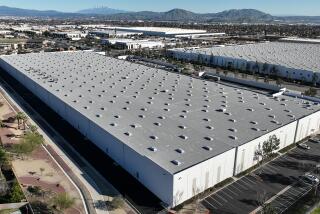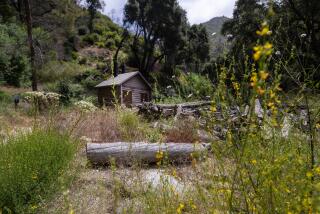Panel Seeks to Tie Landfill Expansion to Dumping Limits
A Los Angeles City Council committee proposed Tuesday that sanitation officials be allowed to expand the Lopez Canyon dump only if the amount of trash taken there is limited and neighbors are compensated with $5-million worth of parks, trees and other amenities.
The council’s Planning and Land Use Management Committee said tough new rules are the price the Bureau of Sanitation must pay to secure a conditional use permit allowing it to expand the dump in Lake View Terrace, where most of the city’s refuse goes. The council is expected to vote on the matter later this month.
The proposal gladdened neighbors and lawmakers who have long protested that the dump is a source of methane gas leaks, noise, dust and odors.
“It’s been a long struggle, and we’re now getting conditions that are of substantial benefit,” said Councilman Ernani Bernardi, who represents Lake View Terrace.
“A great victory,” said Rob Zapple, a founder of Communities United for Safe Trash Management, or CUSTOM. For two years, CUSTOM has sharply attacked the city for failing to control the leakage of methane gas from Lopez Canyon.
Councilman Hal Bernson, who heads the planning panel and has engaged in a long-running struggle against proposals to expand Sunshine Canyon landfill in Granada Hills, repeatedly sided with residents.
“If you think I’m a little tough, it’s only because I lived with this also,” Bernson, who represents the northern San Fernando Valley, told sanitation officials at one point during the testimony. “Mr. Bernardi’s district and mine have been the garbage cans for the city too long.”
The proposal would give the Bureau of Sanitation a five-year license--instead of the 15 years the bureau originally sought--to dump in the so-called Canyon C area of Lopez, where no dumping is now allowed. The extension of landfill operations into this area of the 392-acre municipal dump is proposed because other parts of the canyon are filling to capacity with refuse.
One of the major conditions proposed was a 4,000-ton-per-day limit on the amount of garbage that can be dumped at the site. The bureau is now dumping about that amount at the site, but it had sought permission for 7,200 tons per day. The city’s Planning Commission last August approved 6,400 tons per day.
The rules would limit the bureau to 400 truckloads a day, about the current level.
The planning committee also forbade the bureau to dig out the canyon to make room for more than 5.2 million tons of garbage.
Lew Snow, a leader of CUSTOM, said this would prevent the bureau from “digging a gaping crater at Canyon C and then saying at the end of five years that it has to be filled up” with more garbage.
The planning panel also backed two measures pushed by Bernardi, one of which would require the city to set up a $5-million fund to compensate the people around Lopez for the aggravation of living next to a dump.
Under the “community amenities package,” the City Council would set aside $1 million per year to build recreational facilities, plant trees or begin recycling projects in the areas surrounding the landfill, Bernardi said. A committee appointed by local lawmakers would decide which projects to finance.
Councilman Joel Wachs, whose district is near the landfill, told the committee that the residents deserved to be “rewarded for having to bear the burdens” of the landfill. Bureau of Sanitation Director Delwin Biagi declined to comment on the restrictions, the strongest imposed on the landfill since it opened in 1975.
More to Read
Sign up for Essential California
The most important California stories and recommendations in your inbox every morning.
You may occasionally receive promotional content from the Los Angeles Times.










